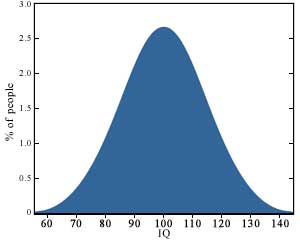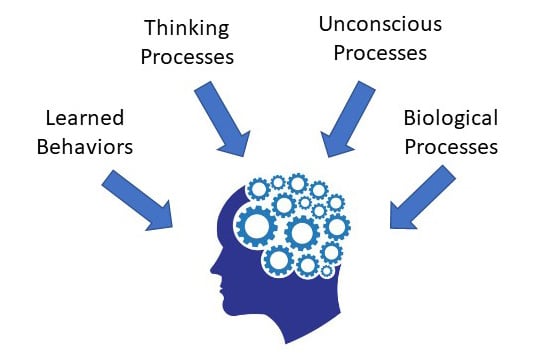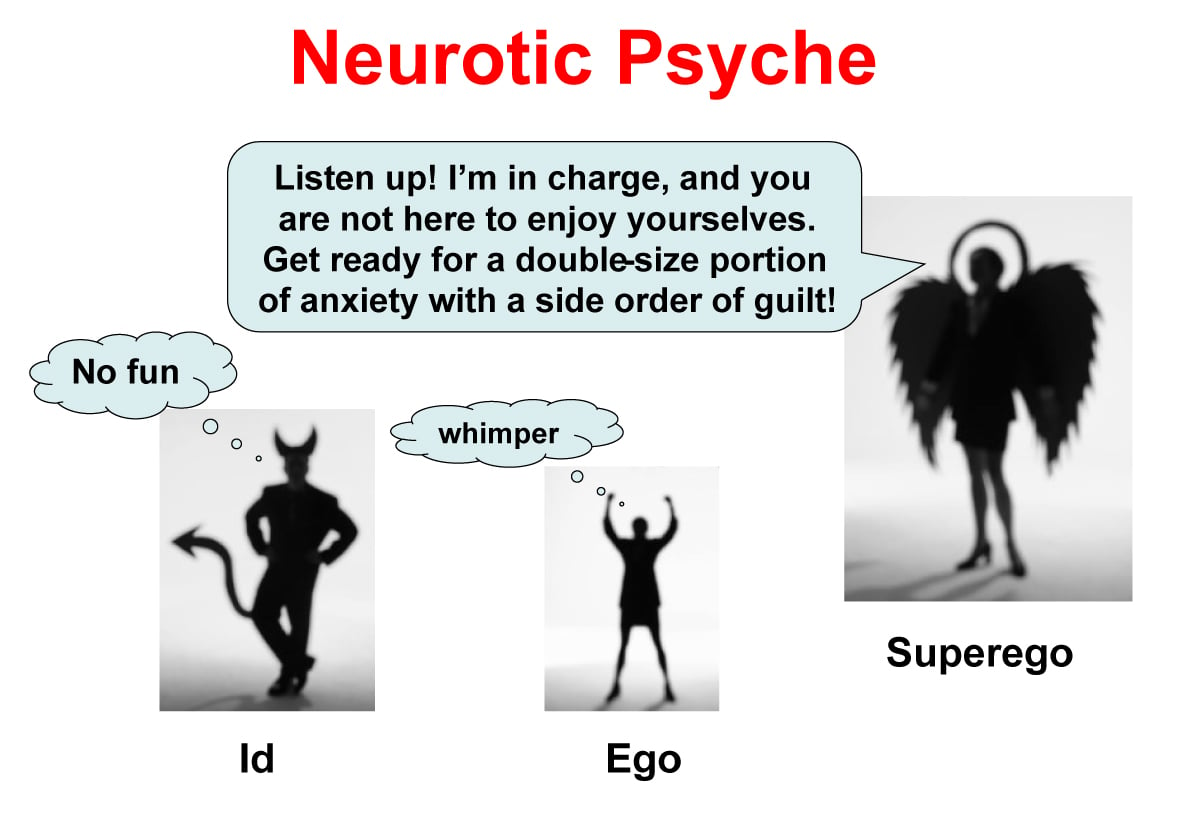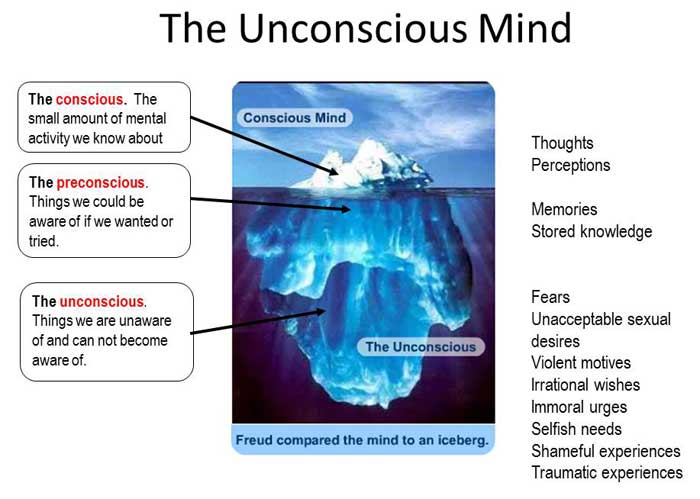Abnormal psychology is a branch of psychology that studies, diagnoses, and treats unusual patterns of behavior, emotions, and thoughts that could signify a mental disorder.
Abnormal psychology studies people who are “abnormal” or “atypical” compared to the members of a given society.
Remember, “abnormal” in this context does not necessarily imply “negative” or “bad.” It is a term used to describe behaviors and mental processes that significantly deviate from statistical or societal norms.
Abnormal psychology research is pivotal for understanding and managing mental health issues, developing treatments, and promoting mental health awareness.
Defining Abnormality
The definition of the word abnormal is simple enough, but applying this to psychology poses a complex problem:
What is normal? Whose norm? For what age? For what culture?
The concept of abnormality is imprecise and difficult to define. Examples of abnormality can take many different forms and involve different features, so that, what at first sight seem quite reasonable definitions, turns out to be quite problematic.
There are several different ways in which it is possible to define ‘abnormal’ as opposed to our ideas of what is ‘normal.’
Statistical Infrequency
Under this definition of abnormality, a person’s trait, thinking or behavior is classified as abnormal if it is rare or statistically unusual.
With this definition, it is necessary to be clear about how rare a trait or behavior needs to be before we class it as abnormal. For instance, one may say that an individual who has an IQ below or above the average level of IQ in society is abnormal.

Strength
The statistical approach helps to address what is meant by normal in a statistical context. It helps us make cut–off points in terms of diagnosis.
Limitations
However, this definition fails to distinguish between desirable and undesirable behavior. For example, obesity is statistically normal but not associated with healthy or desirable. Conversely, a high IQ is statistically abnormal but may well be regarded as highly desirable.
Many rare behaviors or characteristics (e.g., left-handedness) have no bearing on normality or abnormality. Some characteristics are regarded as abnormal even though they are quite frequent.
Depression may affect 27% of elderly people (NIMH, 2001). This would make it common, but that does not mean it isn’t a problem.
The decision of where to start the “abnormal” classification is arbitrary. Who decides what is statistically rare, and how do they decide? For example, if an IQ of 70 is the cut-off point, how can we justify saying someone with 69 is abnormal, and someone with 70 is normal?
This definition also implies that abnormal behavior in people should be rare or statistically unusual, which is not the case.
Instead, any specific abnormal behavior may be unusual, but it is not unusual for people to exhibit some form of prolonged abnormal behavior at some point in their lives, and mental disorders such as depression are very statistically common.
Violation of Social Norms
Violation of social norms is a definition of abnormality where a person’s thinking or behavior is classified as abnormal if it violates the (unwritten) rules about what is expected or acceptable behavior in a particular social group. Their behavior may be incomprehensible to others or make others feel threatened or uncomfortable.
Every culture has certain standards for acceptable behavior or socially acceptable norms.
Norms are expected ways of behaving in a society according to the majority, and those members of a society who do not think and behave like everyone else break these norms and are often defined as abnormal.
With this definition, it is necessary to consider the degree to which a norm is violated, the importance of that norm, and the value attached by the social group to different sorts of violations, e.g., is the violation rude, eccentric, abnormal, or criminal?
There are a number of influences on social norms that need to be taken into account when considering the definition of the social norm:
| Culture | Different cultures and subcultures are going to have different social norms.
For example, it is common in Southern Europe to stand much closer to strangers than in the UK. Voice pitch and volume, touching, the direction of gaze, and acceptable subjects for discussion have all been found to vary between cultures. |
| Context and Situation | At any one time, a type of behavior might be considered normal, whereas, at another time, the same behavior could be abnormal, depending on both context and situation.
For example, wearing a chicken suit in the street for a charity event would seem normal, but wearing a chicken suit for everyday activities, such as shopping or going to church, would be socially abnormal. |
| Historical Context | Time must also be taken into account, as what is considered abnormal at one time in one culture may be normal at another time, even in the same culture.
For example, one hundred years ago, a pregnancy outside of marriage was considered a sign of mental illness, and some women were institutionalized, whereas now this is not the case |
| Age and Gender | Different people can behave in the same way, and some will be normal and others abnormal, depending on age and gender (and sometimes other factors).
For example, a man wearing a dress and high heels may be considered socially abnormal as society would not expect it, whereas this is expected of women |
With this definition, it is necessary to consider the following:
- The degree to which a norm is violated,
- The importance of that norm,
- The value attached by the social group to different sorts of violations, e.g., is the violation rude, eccentric, abnormal, or criminal?
Limitations
The most obvious problem with defining abnormality using social norms is that there is no universal agreement
over social norms.
Social norms are culturally specific – they can differ significantly from one generation to the next and between different ethnic, regional, and socio-economic groups.
In some societies, such as the Zulu, for example, hallucinations and screaming in the street are regarded as normal behavior.
Social norms also exist within a time frame and therefore change over time. Behavior that was once seen as abnormal may, given time, become acceptable and vice versa.
For example, drunk driving was once considered acceptable but is now seen as socially unacceptable, whereas homosexuality has gone the other way.
Until 1980 homosexuality was considered a psychological disorder by the World Health Organization (WHO), but today is socially acceptable.
Social norms can also depend on the situation or context we find ourselves in. Is it normal to eat parts of a dead body?
In 1972 a rugby team who survived a plane crash in the snow-capped Andes of South America found themselves without food and in sub-freezing temperatures for 72 days. To survive, they ate the bodies of those who had died in the crash.
Failure to Function Adequately
Failure to function adequately is a definition of abnormality where a person is considered abnormal if they are unable to cope with the demands of everyday life, or experience personal distress.
They may be unable to perform the behaviors necessary for day-to-day living, e.g., self-care, holding down a job, interacting meaningfully with others, making themselves understood, etc.
Rosenhan & Seligman (1989) suggest the following characteristics that define failure to function adequately:
- Suffering
- Maladaptiveness (danger to self)
- Vividness & unconventionality (stands out)
- Unpredictably & a loss of control
- Irrationality/incomprehensibility
- Causes observer discomfort
- Violates moral/social standards
Limitations
One limitation of this definition is that apparently abnormal behavior may actually be helpful, functional, and adaptive for the individual.
For example, a person who has the obsessive-compulsive disorder of hand-washing may find that the behavior makes him cheerful, happy, and better able to cope with his day.
Many people engage in behavior that is maladaptive/harmful or threatening to self, but we don’t class them as abnormal:
- Adrenaline sports
- Smoking, drinking alcohol
- Skipping classes
Deviation from Ideal Mental Health
Abnormality can be defined as a deviation from ideal mental health.
This means that rather than defining what is abnormal, psychologists define what normal/ideal mental health is, and anything that deviates from this is regarded as abnormal.
This requires us to decide on the characteristics we consider necessary for mental health. Jahoda (1958) defined six criteria by which mental health could be measured:
- A positive view of the self
- Capability for growth and development
- Autonomy and independence
- Accurate perception of reality
- Positive friendships and relationships
- Environmental mastery – able to meet the varying demands of day-to-day situations
According to this approach, the more satisfied these criteria are, the healthier the individual is.
Limitations
It is practically impossible for any individual to achieve all of the ideal characteristics all of the time. For example, a person might not be the ‘master of his environment’ but be happy with his situation.
The absence of this criterion of ideal mental health hardly indicates he is suffering from a mental disorder.
Ethnocentric
Ethnocentrism, in the context of psychology, refers to the tendency to view one’s own culture or ethnic group as the standard or norm, and to judge other cultures, values, behaviors, and beliefs based on those norms. I
White, middle-class men devise most definitions of psychological abnormality. It has been suggested that this may lead to disproportionate numbers of people from certain groups being diagnosed as “abnormal.”
For example, in the UK, depression is more commonly identified in women, and black people are more likely than their white counterparts to be diagnosed with schizophrenia.
Similarly, working-class people are more likely to be diagnosed with a mental illness than those from non-manual backgrounds.
Models of Abnormality

Behavioral Model of Abnormality
Behaviorists believe that our actions are determined largely by the experiences we have in life rather than by the underlying pathology of unconscious forces.
Abnormality is therefore seen as the development of behavior patterns that are considered maladaptive (i.e., harmful) for the individual.
Behaviorism states that all behavior (including abnormal) is learned from the environment (nurture) and that all behavior that has been learned can also be ‘unlearnt’ (which is how abnormal behavior is treated).
The behavioral approach emphasizes the environment and how abnormal behavior is acquired through classical conditioning, operant conditioning, and social learning.
Classical conditioning has been said to account for the development of phobias. The feared object (e.g., spider or rat) is associated with fear or anxiety sometime in the past. The conditioned stimulus subsequently evokes a powerful fear response characterized by avoidance of the feared object and the emotion of fear whenever the object is encountered.
Learning environments can reinforce (re: operant conditioning) problematic behaviors. E.g., an individual may be rewarded for having panic attacks by receiving attention from family and friends – this would lead to the behavior being reinforced and increasing in later life.
Our society can also provide deviant maladaptive models that children identify with and imitate (re: social learning theory).
Cognitive Perspective of Mental Health Behavior
The cognitive approach assumes that a person’s thoughts are responsible for their behavior. The model deals with how information is processed in the brain and the impact of this on behavior.
The basic assumptions are:
- Maladaptive behavior is caused by faulty and irrational cognitions.
- It is the way you think about a problem rather than the problem itself that causes mental disorders.
- Individuals can overcome mental disorders by learning to use more appropriate cognitions.
The individual is an active processor of information.
How a person perceives, anticipates, and evaluates events rather than the events themselves, which will have an impact on behavior.
This is generally believed to be an automatic process; in other words, we do not think about it.
In people with psychological problems, these thought processes tend to be negative, and the cognitions (i.e., attributions, cognitive errors) made will be inaccurate:
These cognitions cause distortions in how we see things; Ellis suggested it is through irrational thinking, while Beck proposed the cognitive triad.
Medical / Biological Perspective of Mental Health Behavior
The medical model of psychopathology believes that disorders have an organic or physical cause. The focus of this approach is on genetics, neurotransmitters, neurophysiology, neuroanatomy, biochemistry, etc.
For example, in terms of biochemistry – the dopamine hypothesis argues that elevated levels of dopamine are related to symptoms of schizophrenia.
The approach argues that mental disorders are related to the physical structure and functioning of the brain.
For example, differences in brain structure (abnormalities in the frontal and pre-frontal cortex, enlarged ventricles) have been identified in people with schizophrenia.
The Diathesis-Stress Model
According to the diathesis-stress model, the emergence of a psychological disorder requires first the existence of a diathesis, or an innate predisposition to that disorder in an individual, and second, stress, or a set of challenging life circumstances which then trigger the development of the disorder.
In the diathesis-stress model, these challenging life events are thought to interact with individuals’ innate dispositions to bring psychological disorders to the surface.
For example, traumatic early life experiences, such as the loss of a parent, can act as longstanding predispositions to a psychological disorder. In addition, personality traits like high neuroticism are sometimes also referred to as diatheses.
Furthermore, individuals with greater innate predispositions to a disorder may require less stress for that disorder to be triggered, and vice versa.
In this way, the diathesis-stress model explains how psychological disorders might be related to both nature and nurture and how those two components might interact with one another (Broerman, 2017).
Psychodynamic Perspective of Mental Health Behavior
The main assumptions include Freud’s belief that abnormality came from psychological causes rather than physical causes, that unresolved conflicts between the id, ego, and superego can all contribute to abnormality, for example:
- Weak ego: Well-adjusted people have a strong ego that can cope with the demands of both the id and the superego by allowing each to express itself at appropriate times. If the ego is weakened, then either the id or the superego, whichever is stronger, may dominate the personality.
- Unchecked id impulses: If id impulses are unchecked, they may be expressed in self-destructive and immoral behavior. This may lead to disorders such as conduct disorders in childhood and psychopathic [dangerously abnormal] behavior in adulthood.
- Too powerful superego: A superego that is too powerful, and therefore too harsh and inflexible in its moral values, will restrict the id to such an extent that the person will be deprived of even socially acceptable pleasures. According to Freud, this would create neurosis, which could be expressed in the symptoms of anxiety disorders, such as phobias and obsessions.

Freud also believed that early childhood experiences and unconscious motivation were responsible for disorders.

An Alternative View: Mental Illness is a Social Construction
Since the 1960s, it has been argued by anti-psychiatrists that the entire notion of abnormality or mental disorder is merely a social construction used by society.
Notable anti-psychiatrists were Michel Foucault, R.D. Laing, Thomas Szasz, and Franco Basaglia. Some observations made are:
- Mental illness is a social construct created by doctors. An illness must be an objectively demonstrable biological pathology, but psychiatric disorders are not.
- The criteria for mental illness are vague, subjective, and open to misinterpretation criteria.
- The medical profession uses various labels, e.g., depressed and schizophrenic, to exclude those whose behavior fails to conform to society’s norms.
- Labels and treatment can be used as a form of social control and represent an abuse of power.
- Diagnosis raises issues of medical and ethical integrity because of financial and professional links with pharmaceutical companies and insurance companies.
Why is abnormal psychology important?
Abnormal psychology is a crucial field that focuses on understanding, diagnosing, and treating atypical behaviors, emotions, and thought processes, which can lead to mental disorders.
Its importance lies in enhancing our comprehension of mental health disorders, developing effective treatment strategies, and promoting mental health awareness to reduce stigma.
Additionally, this field helps in implementing preventive measures, guiding mental health legislation and policies, improving the quality of life for those with mental health issues, and serving as an educational tool for professionals and the public.
Through these various contributions, abnormal psychology helps foster a better understanding and handling of mental health matters in society.
How did the study of abnormal psychology originate?
The study of abnormal psychology originated in ancient times, with early explanations attributing abnormal behaviors to supernatural forces. The Greeks later proposed naturalistic explanations, such as Hippocrates’ theory of bodily humors.
After regression during the Middle Ages, the field progressed in the 19th and 20th centuries, with figures like Philippe Pinel and Sigmund Freud advocating humane treatment and developing therapeutic approaches, respectively.
The 20th century also saw the creation of the Diagnostic and Statistical Manual of Mental Disorders (DSM). Currently, the field draws from various disciplines, including psychology, psychiatry, neuroscience, and genetics.
What are the 4 key objectives of the field of abnormal psychology?
The field of abnormal psychology has four primary objectives:
Description: This involves accurately describing, defining, and classifying different psychological disorders. This is important for practitioners and researchers to communicate effectively about each disorder.
Explanation: This involves determining the causes or etiology of different disorders. Researchers aim to understand the biological, psychological, and social factors that contribute to the development and maintenance of abnormal behaviors or mental health disorders.
Prediction: By understanding the course of different disorders, psychologists can predict how they might develop or change over time. This can help forecast the likely course of a disorder in an individual, given certain characteristics or conditions.
Change: Ultimately, the goal of abnormal psychology is to develop effective interventions and treatments that can alleviate the suffering caused by mental health disorders. This objective seeks to change maladaptive behaviors, thoughts, and emotions, promoting mental well-being and functional life skills.
What makes defining abnormality difficult?
Defining abnormality in psychology is challenging due to cultural variations, subjectivity, context-dependent norms, societal changes over time, and difficulty discerning when behaviors or emotions become clinically significant. Cultural norms heavily influence perceptions of normality and abnormality.
Additionally, what’s considered abnormal in one context may be normal in another. Definitions also evolve with societal and scientific progress. Furthermore, distinguishing when feelings like sadness or anxiety become severe or prolonged enough to be deemed abnormal is complex.
These factors highlight the need for a nuanced, culturally sensitive, and individualized approach to abnormal psychology.
Why are correlational research designs often used in abnormal psychology?
Correlational research designs are often used in abnormal psychology because they allow researchers to examine the relationship between different variables without manipulating them, which can provide valuable insights into mental health conditions. These designs are particularly useful in cases where variables cannot be manipulated for ethical or practical reasons.
For example, it would be unethical and impractical to manipulate a factor such as childhood trauma to observe its effects on mental health in adulthood. However, a correlational design would allow researchers to examine the relationship between these variables as they naturally occur.
Additionally, correlational designs can help identify risk factors for various mental health conditions. For instance, researchers might find that high-stress levels correlate with an increased risk of depression. Such findings can provide a foundation for preventive measures and guide future research.
However, a key limitation of correlational research is that it cannot establish causality. Just because two variables are correlated does not mean one causes the other. Therefore, correlational findings often need to be followed up by experimental or longitudinal studies to explore potential causal relationships.

